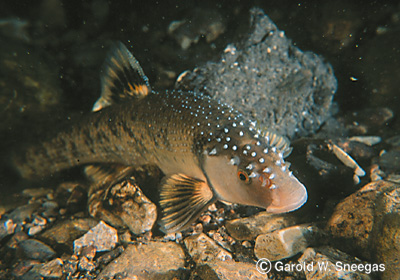Fish Iowa - Fish Species - Central Stoneroller

Characteristics
Body form varies from slender to moderately stout. They are slightly compressed laterally with an arch in the back. The horizontal mouth is sub-terminal and lacks a barbel. A cartilaginous and chisel-shaped lower jaw is a distinct characteristic of stonerollers. Slender arches support the slightly hooked pharyngeal teeth, which are arranged in a 4-4 pattern. The lateral line is complete, with 49 to 55 scales, and the circumferential scale counts (around the body frontal of the dorsal fin) range from 39 to 55. Dorsal and pelvic fins ray count are 8, while the pectoral fins have 15 rays and the anal fins 7 rays. The long intestine is usually wrapped around the air bladder, and it is covered by a black peritoneum. The body is brownish-olive with a brassy luster above and silvery to white beneath. Body sides are marked with scattered dark scales, giving the fish a mottled look. Spawning males develop a dark bar across the anal fin and have tubercles on their back, top of the head, and between the nostrils.
Foods
Stonerollers feed by scraping the algae and bottom ooze from submerged objects.
Expert Tip
Spawning males develop a dark bar across the anal fin and have tubercles on their back, top of the head, and between the nostrils, as shown in the photo above.
Details
The Central Stoneroller lives in many habitats from very small streams to large rivers. Some researchers have found that the largest populations were found where a combination of habitats was available such as small streams with moderate to high gradients with sandy-gravel bottoms in which to spawn, moderate-sized streams with moderate gradients in which to summer, and larger streams of lower gradients in which to winter. In Iowa, the Central Stoneroller lives in small creeks, reaching its highest abundance in coolwater streams. The Central Stoneroller prefers clear water, but can tolerate turbidity if the bottom is free of silt, stays reasonably cool and is well oxygenated.
Spawning peaks during April, when males built nests by moving gravel with their mouths or nudging it away with their snouts, giving rise to their common name. Adults may reach 7-inches long.
Recent stream sampling information is available from Iowa DNR's biological monitoring and assessment program.
Sources:
Harlan, J.R., E.B. Speaker, and J. Mayhew. 1987. Iowa fish and fishing. Iowa Conservation Commission, Des Moines, Iowa. 323pp.
Loan-Wilsey, A. K., C. L. Pierce, K. L. Kane, P. D. Brown and R. L. McNeely. 2005. The Iowa Aquatic Gap Analysis Project Final Report. Iowa Cooperative Fish and Wildlife Research Unit, Iowa State University, Ames.
Photo credit: Photo courtesy of Garold W. Sneegas, copyright Garold W. Sneegas
Distribution Map

Throughout Iowa, except for extreme southwest Iowa. It is found along the whole length of the Mississippi River. One of Iowa’s more abundant cyprinids, the Central Stoneroller is common in most stream fish collections.
See our most recent distribution data for this species on the Iowa DNR's Bionet application.
State Record(s)
No state record exists for this species
Submit your potential recordMaster Angler Catches
No Master Angler catches currently exist for this species.
Submit your Master Angler catchFish Surveys
Tip: Click Species Length by Site, then use the dropdown to filter by fish species of interest.Where this Fish Is Found
Baileys Ford
Bear Creek
Bigalk Creek
Bloody Run Creek
Bohemian Creek
Brush Creek
Buck Creek
Coon Creek
East Nodaway River
East Pine Creek
Fountain Springs
Little Mill Creek
Little Turkey River
Little Turkey River (put and grow)
McLoud Run
Miners Creek
Mink Creek
Monastery Creek
Otter Creek
Richmond Springs
South Cedar Creek
Spring Branch
Spring Creek
Swiss Valley Creek
Tete des Morts River
tributaries to Tete des Morts River
Trout Run (Winneshiek)
Twin Bridges
Upper Swiss Valley Creek
Wapsi River (Trout Section)
West Fork Grand River
White Pine Hollow
Yellow River (Trout Section)